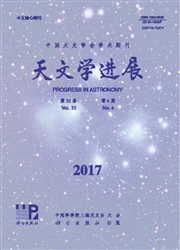

 中文摘要:
中文摘要:
硅酸盐是宇宙尘埃的主要成分之一。20世纪60年代,在演化晚期恒星中就曾发现硅酸盐尘埃的辐射特征,并且与实验室无定形硅酸盐的光谱特征非常吻合。到20世纪90年代,演化晚期恒星中的结晶硅酸盐特征首次在ISO卫星拍摄的光谱中探测到,其后随着更多的红外空间天文台(Spitzer、Herschel等)的发射,发现了大量具有结晶硅酸盐特征的恒星,尤其是演化晚期恒星,几乎涵盖了演化晚期的各个阶段(红巨星、渐近巨星支星、原行星状星云、行星状星云、红超巨星等)。结晶硅酸盐尘埃的特征广泛分布在10~70μm波长范围内,表现为多个丰富的谱带。阐述了演化晚期恒星中结晶硅酸盐尘埃的发现、谱特征、观测特性、结晶度和形成机制。
 英文摘要:
英文摘要:
Silicate is the most abundant cosmic dust which may present in two forms:amorphous and crystalline. Due to the difference in structure, the two types of silicate dust can be distinguished from their spectral features in the infrared. The amorphous silicate dust was discovered early in 1960 s by their smooth and broad features at 10 and 18 micron. In particular, the all-sky survey by InfraRed Astronomical Satellite/Low Resolution Spectrometer revealed the popularity of amorphous silicate dust in the circumstellar envelope of evolved stars such as AGB and post-AGB stars. Meanwhile, the crystalline silicate outside the solar system was not definitely identified until the successful observation in the even longer wavelength range by the high resolution spectrometers board on the Infrared Space Observatory. It was found that the crystalline silicate dust emits a series of narrow and sharp features spanning the infrared spectrum from 10 to 70 micron, with the most prominent features being the complexes around 10, 18, 23, 28, 33, 40 and 60 micron. These features are detected in various scales, from our solar system objects to distant galaxies, including comets, the pre-planetary disk around Herbig Ae/Be and T Tauri stars, the debris disk of main-sequence stars, circumstellar envelop around evolved stars, ultra-luminous infrared galaxies, and even quasars. On the other hand, there has been no clear detection of crystalline silicate in the interstellar medium of the Milky Way galaxy, which addresses a question how the crystalline silicate dust evolves in the interstellar medium.The crystalline silicate dust is detected in every phase of late stellar evolution, i.e,red giants, AGB stars, post-AGB stars, planetary nebulae at the low-mass end, and red supergiants, luminous blue variables, supernova remnants at the high-mass end. The characteristics(such as peak wavelength and FWHM) of the spectral features(in particular the features at 33.6 and 69 microns) in the evolved stars indicate that the crystalline silicate
 同期刊论文项目
同期刊论文项目
 同项目期刊论文
同项目期刊论文
 期刊信息
期刊信息
